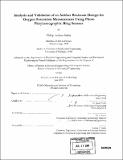| dc.contributor.advisor | H. Harry Asada. | en_US |
| dc.contributor.author | Shaltis, Phillip Andrew | en_US |
| dc.contributor.other | Massachusetts Institute of Technology. Dept. of Mechanical Engineering. | en_US |
| dc.date.accessioned | 2005-09-06T21:48:29Z | |
| dc.date.available | 2005-09-06T21:48:29Z | |
| dc.date.copyright | 2004 | en_US |
| dc.date.issued | 2004 | en_US |
| dc.identifier.uri | http://hdl.handle.net/1721.1/27113 | |
| dc.description | Thesis (S.M.)--Massachusetts Institute of Technology, Dept. of Mechanical Engineering; and, (S.M.)--Massachusetts Institute of Technology, Dept. of Electrical Engineering and Computer Science, 2004. | en_US |
| dc.description | Includes bibliographical references (leaves 99-103). | en_US |
| dc.description.abstract | Recent advances in continuous noninvasive health monitoring technologies provide clinicians and researchers with a previously unrealistic opportunity for closely tracking the developments and treatments of various pathologies both within and outside of a clinical setting. At the same time, miniaturized, wireless communication technologies have greatly enhanced the transmission of sensor data while reducing the size requirements for traditional, wearable sensors. The synergism of these innovations has led to the development of the Ring Sensor, a miniaturized, telemetric, photo plethysmograph sensor for continuous health monitoring. Previous work on the Ring Sensor has led to significant power savings in regards to data acquisition and transmission. Additionally, early long-term monitoring tests have indicated that the Ring Sensor is capable of acquiring a reliable waveform nearly 30% of the time. However, the utility of the Ring Sensor has remained somewhat limited. This thesis addresses several of the remaining issues associated with the Ring Sensor. The main design consideration associated with the Ring Sensor is achieving minimal power consumption while maintaining high signal quality. To this end, significant effort has been channeled to the development of an appropriate motion artifact model, representing the complex interplay between internal hemodynamics and external influences. Additionally, an artifact resistant, power-efficient, high-speed modulation scheme has been incorporated into the design of the Ring Sensor. It has been shown that this design significantly reduces the amount of data corrupted by motion while also minimizing the power consumed by the LEDs (one of the single largest power consuming elements). | en_US |
| dc.description.abstract | (cont.) This thesis also details the refinement of both the analog signal processing circuit and the redesigning of the sensor band for a more secure device interface. In particular, the order and type of filtering utilized by the Ring Sensor have been optimized for signal quality and stability. An improved sensor unit assembly provides a secure, pressurized contact with the patient's skin while protecting the optical components and wires from the external environment, while additional sensors, incorporated into both the sensor band and the ring unit, provide temperature and light feedback for signal quality assurance. In addition to these advancements, preliminary work towards sensor calibration for oxygen saturation measurements is provided. The thesis concludes with promising results obtained from field testing work conducted in the Massachusetts General Hospital's Pulmonary Function Testing Lab. | en_US |
| dc.description.statementofresponsibility | by Phillip Andrew Shaltis. | en_US |
| dc.format.extent | 103 leaves | en_US |
| dc.format.extent | 5438181 bytes | |
| dc.format.extent | 5450148 bytes | |
| dc.format.mimetype | application/pdf | |
| dc.format.mimetype | application/pdf | |
| dc.language.iso | en_US | |
| dc.publisher | Massachusetts Institute of Technology | en_US |
| dc.rights | M.I.T. theses are protected by copyright. They may be viewed from this source for any purpose, but reproduction or distribution in any format is prohibited without written permission. See provided URL for inquiries about permission. | en_US |
| dc.rights.uri | http://dspace.mit.edu/handle/1721.1/7582 | |
| dc.subject | Electrical Engineering and Computer Science. | en_US |
| dc.subject | Mechanical Engineering. | en_US |
| dc.title | Analysis and validation of an artifact resistant design for oxygen saturation measurement using photo pletyhsmographic ring sensors | en_US |
| dc.type | Thesis | en_US |
| dc.description.degree | S.M. | en_US |
| dc.contributor.department | Massachusetts Institute of Technology. Department of Electrical Engineering and Computer Science | |
| dc.contributor.department | Massachusetts Institute of Technology. Department of Mechanical Engineering | |
| dc.identifier.oclc | 56842214 | en_US |
